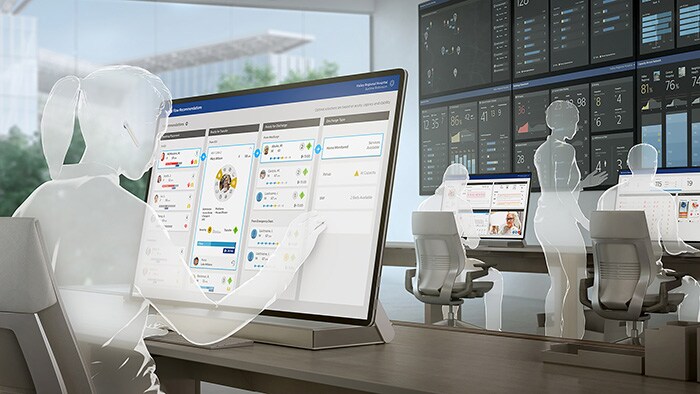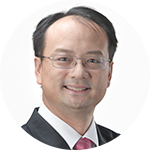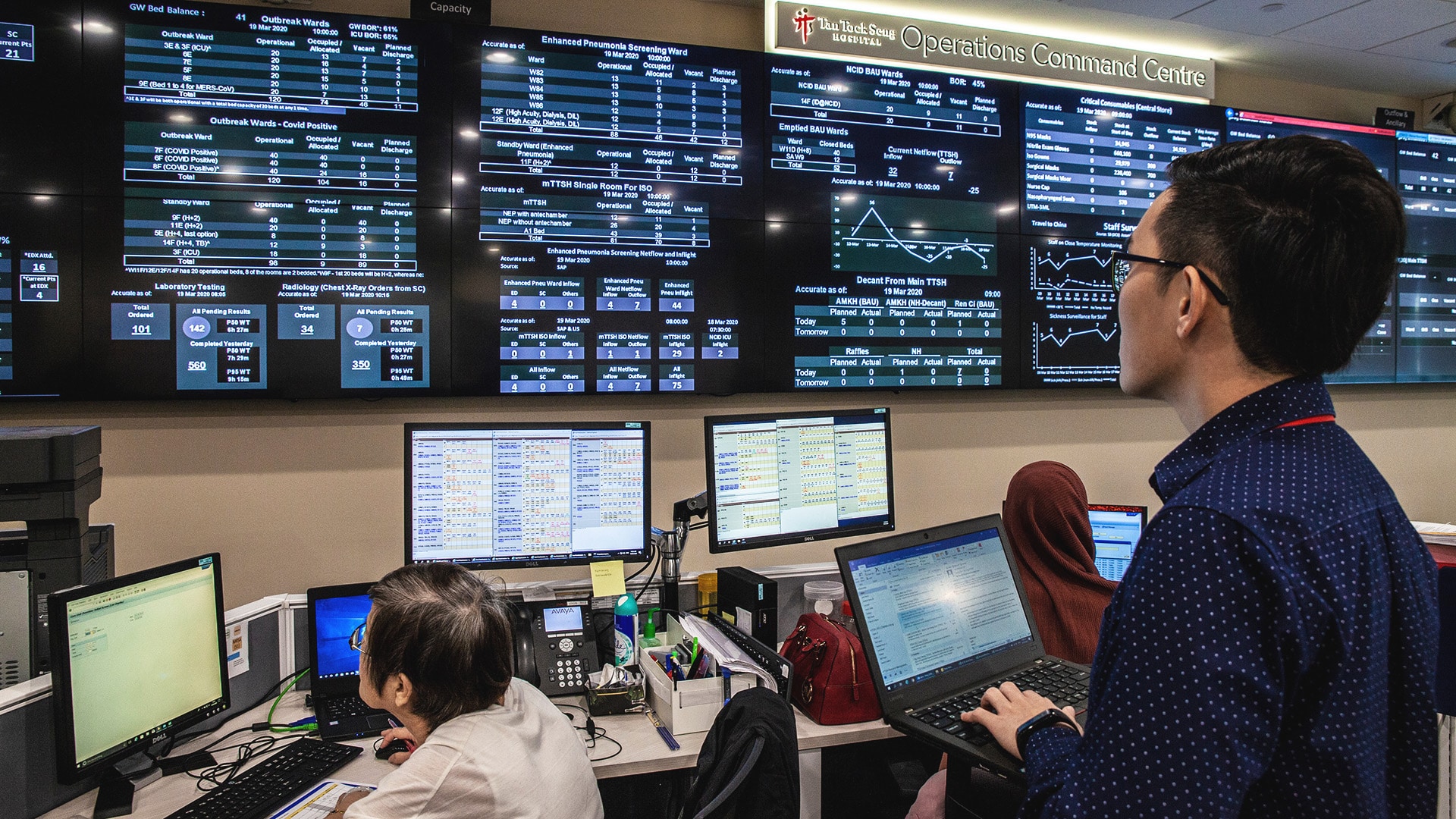How a central command center helped Singapore’s National Healthcare Group streamline care delivery
Oct 10, 2023 - Reading time 6-8 minutes
Healthcare leaders in the Asia Pacific region are at the forefront of using digital technology to reduce the impact of workforce shortages, according to the Philips Future Health Index 2023 report. Two-thirds (67%) of them (versus 56% globally) already use, or plan to use, digital health technology for this purpose, with 75% of leaders in Singapore focused on this. How are these new technologies making a difference? We asked Dr Eric Wong, Group Chief Data and Strategy Officer for the National Healthcare Group in Singapore – where he spearheads the vision, strategy, and execution of advanced digital health capabilities.

The National Health Group (NHG) is a leader in public healthcare in Singapore. It operates several hospitals (one of which was featured in Newsweek’s 2023 list of the world’s best smart hospitals), specialty centers, including the National Centre for Infectious Diseases, and polyclinics. NHG is also the Regional Health Manager for 1.5 million residents in Central and North Singapore, and actively collaborates with private general practices, public and community health and social care providers to keep residents well and healthy. Like other healthcare institutions around the world, NHG faces increasing demands from a rapidly ageing population. It is estimated that Singapore needs another 24,000 nurses, allied health professionals and support care staff by 2030 [1]. The COVID-19 pandemic has also put immense pressure on the organization’s workforce over the past few years. In the face of these challenges, NHG has made great strides in streamlining its care processes and reducing administrative workload, allowing staff to focus on patient care. Among other digital health innovations is the development of a Command, Control and Communications (C3) system, operating from its flagship Tan Tock Seng Hospital (TTSH). C3 was launched just before the start of the pandemic – and it has since proven to be a powerful vehicle for managing patient flow, automating routine manual reporting, and deploying staff and resources where they are needed the most.
Q: Dr Wong, could you take us back to the beginning? Why was the C3 system set up, and how did it help you navigate staffing challenges during the pandemic? A: It started with us being inspired by how other industries, especially the aviation industry (airports and immigration), did capacity planning well. Before the C3 system, we spent considerable time manually aggregating data and creating multiple dashboards to project patient flow and staffing needs for different aspects of hospital operations. With the opening of our National Centre for Infectious Diseases (NCID) in late 2019 (before COVID-19 hit) and the subsequent surge in patient load at NCID and TTSH and across Singapore, we realized there was a need for a more optimal way of processing data. With the C3 system, data is continually streamed from different hospital systems and automatically aggregated, providing real-time situational awareness of our overall operations. This enables us to gather quick insights that help us project and manage patient flow. We are now able to see in real-time the available capacity in different areas of the hospital based on patient-discharge patterns, and proactively redeploy staff to manage patient load. Such capabilities are even more important in times of a crisis, such as the COVID-19 pandemic, during which we were able to predict the number of patients coming into our screening centers on any given day, allowing us to anticipate and deploy staff between centers to mitigate impending surges.
"We are now able to see in real-time the available capacity in different areas of the hospital based on patient-discharge patterns, and proactively redeploy staff to manage patient load.”

Dr Eric Wong
Group Chief Data and Strategy Officer for the National Healthcare Group, Singapore
Q: What have been the other benefits of having a central command center? A: The biggest value we derive from the C3 system is an efficient and effective way of using data to optimize our operations. At NHG, we are constantly fine-tuning and improving our care processes and seeking to support our teams to do their work better, enhance productivity, and deliver greater value such as better patient experience. Through automated data aggregation and reporting, we have also eased the need for manual administrative work by our care teams, a major push factor for healthcare workers. For example, we saved 2,000 man-days on crisis reporting and screening center management through better capacity planning during the pandemic. Today, we are able to save about 400 man-days from manual data and daily patient flow reporting processes. A: Developing and implementing the C3 system was a collective effort involving our leadership and healthcare staff. The inclusive approach we took was important for several reasons. First, it aligned purpose with ground needs and expectations covering benefits to patients, staff and the organization. Second, it mapped out the roles and responsibilities of staff and the training required to operate the system well beyond their comfort zone and in a fast-evolving environment. Third, it enhanced staff morale during difficult times, as staff saw and understood how their skills positively impacted various parts of the hospital operations. Such digital transformation efforts require early conversations and close collaboration with all stakeholders.
Q: How did you involve staff in implementing the C3 system?

Image source: Tan Tock Seng Hospital
Q: What have been other learnings from implementing the C3 system? A: First was the need to have a clear vision of why we had to implement a command center and its different functions and value to other people. It was important to be clear about the value that the system could provide, especially in the early stages. Second was the need to ensure the quality of the data that went into the system, which determined the quality of its output. When we first started the C3 system, we did not have a consolidated enterprise EMR system within NHG. This meant we spent much time cleaning the data and integrating the relevant systems. Good data management is a critical aspect of making a system work. Third, and most importantly, was the need to make the data dashboard useful to add value to the work of the respective stakeholders. A: Thus far, we have focused its role on running hospital operations – using operational data such as bed utilization, staff availability, etc. In time, we hope to dive deeper into other aspects, such as how to use clinical parameters or patient characteristics to sharpen predictions to help better manage patient flow and capacity planning. It is something we are very interested in as a next step. For example, when we have a 64-year-old female patient with chest pain visiting our hospital, and we have her doctor’s assessment, lab results, and radiology reports – can all that clinical data help bring about more precise predictions for treatment and the specific length of hospital care/stay the patient requires? This would be what I deem as increasing the depth of use of the C3 system. Next, we hope to increase the breadth of its use beyond TTSH and NCID to the other hospitals within NHG. So if we apply our C3 capabilities more widely across our cluster, we could, for example, predict the patient load of each hospital and redeploy resources where necessary for better patient flow and care. A: Building on what I said about the importance of translating data into useful actions, I see a big opportunity for generative AI to support more interactive and real-time data inquiries. Traditionally, we have relied on relatively static dashboards and visualisations, which take effort and skills to adjust for the people using them. With rapid advances in natural language processing, it is fast becoming a reality for people to directly ‘converse’ with data and probe deeper into the data points they are most interested in. It would almost be equivalent to having a super-scientist sitting beside you. More broadly, if we want to better retain our healthcare workers, I believe we need to keep identifying ways to automate administrative and repetitive tasks so that our employees can focus on value-added work, motivated simply by their passion and call of duty for patients – which is CARE. For me, that would be the holy grail. This conversation has been edited for flow and clarity.
Q: How do you see the role of the C3 system evolving in the next few years?
Q: Are there any other innovations that can complement or enhance the effectiveness of a command center in addressing staffing challenges?
References








